Section B.2. Microwave Connector Reference
B 2 Microwave Connector Reference
So you have the radio, an antenna, and a length of cable. How do you connect them together? You need to use connectors that work well in the 2.4 GHz range, fit the kind of cabling you're using, and mate with each other. Practically all common connectors have two halves, a male and a female (or a pin and a socket). A few of the more exotic types (such as the APC-7; see later in this section) are sexless, so any connector will match up with any other. Here are the most common connectors you are likely to encounter in the microwave bestiary.
The BNC (Bayonet Neill Concelman) connector, as shown in Figure B-1, is a small, cheap connector using a quick-connect half turn (the same connector found on 10base2 Ethernet). The BNC isn't well suited for 2.4 GHz use, but is mentioned here because, with the death of 10base2, the connectors are frequently sold for pennies per pound. Don't be tempted.
Figure B-1. BNC connector
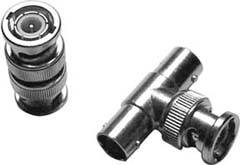
The TNC (Figure B-2) is a threaded version of the BNC. The fine threads help eliminate leakage at microwave frequencies. TNCs work well all the way through 12 GHz, and are usually used with smaller (and higher-loss) cable.
An N (Neill) connector (Figure B-3) is a larger, threaded connector found on many commercial 2.4 GHz antennas. It is much larger than the TNC. It works very well on thicker cable (such as LMR-400) and operates well up to 10 GHz. The N is probably the most commonly encountered connector when dealing with 802.11b/g-compatible gear.
The connector commonly referred to as a "UHF" connector looks like a coarse-thread version of the N (Figure B-4). It is not usable for 2.4 GHz, but is sometimes confused with the N. According to the ARRL Microwave manual, it's a PL-259 (which mates with the SO-239 socket). It's not designed to work at microwave frequencies. Avoid this connector.
Figure B-2. TNC connector
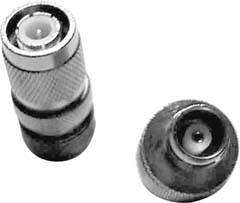
Figure B-3. N connector.
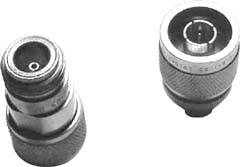
SMA (Sub-Miniature, variation A) connectors (Figure B-5) are very popular, small, threaded connectors that work great through 18 GHz. Their small size precludes using them with large, low-loss cable without using a pigtail.
The SMB (Figure B-6) is a quick-connect version of the SMC.
The SMC (Figure B-7) is a very small version of the SMA. It is designed to work well through 10 GHz, but accepts only very small cables.
The APC-7 (Amphenol Precision) connector, as shown in Figure B-8, is a 7mm sexless connector, usable through 18 GHz. It is a high grade connector manufactured by Amphenol, and is expensive, fairly rare, and very low loss.
Figure B-4. The so-called "UHF" connector
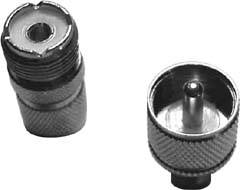
Figure B-5. SMA connector
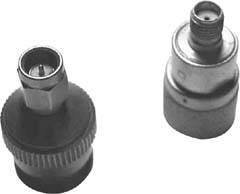
Remember that each connector in the system introduces some loss. Avoid adapters and unnecessary connectors whenever possible. Also, commercially built cables tend to be of higher quality than cables you terminate yourself (unless you're really good and have the right tools). Whenever possible, try to buy a pre-made cable with the proper connectors already attached, at the shortest length you can stand. 802.11b gear doesn't put out much power, and every little bit helps extend your range and reliability. It's very easy to make a bad cable, and bad cables can cause no end of trouble.
When matching cables to your equipment, you may encounter connectors of reverse gender (sometimes called "reverse polarity," or male and female ends swapped with the same threads), reverse threading (lefthand instead of righthand thread), or even reverse gender reverse threading (both). For example, the popular WAP11 uses an RP-TNC. Make sure you know what you're getting before you order parts online!
Figure B-6. SMB connector

Figure B-7. SMC connector (tiny!)
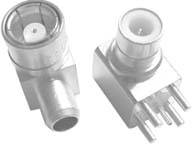
Bluetooth, Mobile Phones, and GPS
- Hacks 122: Introduction
- Hack 1. Set Up Bluetooth on Linux
- Hack 2. Set Up Bluetooth on Windows XP
- Hack 3. Connect Mac OS X with a Bluetooth Phone
- Hack 4. Connect Linux with a Bluetooth Phone
- Hack 5. Connect Windows XP with a Bluetooth Phone
- Hack 6. Use Your Treo as a Modem
- Hack 7. Send SMS from a PowerBook
- Hack 8. Remote Control Mac OS X with Bluetooth Phones and PDAs
- Hack 9. Remote Control Linux with a Bluetooth Phone
- Hack 10. Control XMMS with Bluetooth
- Hack 11. Liven Up Parties with a Participatory Slideshow
- Hack 12. Send SMS from Linux
- Hack 13. Remote Control Windows with Bluetooth Phones and PDAs
- Hack 14. Control Your Bluetooth Phone with FMA
- Hack 15. Control Your Computer from Your Palm
- Hack 16. Control Your Home Theater from Your Palm
- Hack 17. Choose a Cellular Data Plan
- Hack 18. Blog from Your Mobile Phone
- Hack 19. Get Google Maps on Your Mobile Phone
- Hack 20. Share Your GPS
- Hack 21. Broadcast Your GPS Position
- Hack 22. Map Wi-Fi Networks with Kismet and GPSd
Network Discovery and Monitoring
- Hacks 2339: Introduction
- Hack 23. Find All Available Wireless Networks
- Hack 24. Discover Networks with NetStumbler
- Hack 25. Detect Networks with Handheld PCs
- Hack 26. Find and Join Wireless Networks with AP Radar
- Hack 27. Detect Networks on Mac OS X
- Hack 28. Scan Passively with KisMAC
- Hack 29. Detect Networks with Kismet
- Hack 30. Monitor Wireless Links in Linux with Wavemon
- Hack 31. Analyze Traffic with Ethereal
- Hack 32. Track 802.11 Frames in Ethereal
- Hack 33. Watch Network Traffic
- Hack 34. grep Your Network
- Hack 35. Check Wi-Fi Network Performance with Qcheck
- Hack 36. Estimate Network Performance
- Hack 37. Get Real-Time Network Stats
- Hack 38. Graph Your Wireless Performance
- Hack 39. Find Radio Manufacturers by MAC
Wireless Security
- Hacks 4051: Introduction
- Hack 40. Stop Moochers from Stealing Your Wi-Fi Bandwidth
- Hack 41. Visualize a Network
- Hack 42. Secure Your Linux Network with WPA
- Hack 43. Control Wireless Access by MAC
- Hack 44. Authenticate Wireless Users
- Hack 45. Forward Ports over SSH
- Hack 46. Proxy Web Traffic over SSH
- Hack 47. Securely Connect Two Networks
- Hack 48. Generate a Tunnel Configuration Automatically
- Hack 49. Poll Wireless Clients
- Hack 50. Interrogate the Network
- Hack 51. Track Wireless Users
Hardware Hacks
- Hacks 5262: Introduction
- Hack 52. Add an External Antenna
- Hack 53. Do-It-Yourself Access Point Hardware
- Hack 54. Boot from a Compact Flash Hard Drive
- Hack 55. Increase the Range of a PowerBook
- Hack 56. Send Power over Your Ethernet
- Hack 57. The NoCat Night Light
- Hack 58. Upgrade the Linksys WET11
- Hack 59. Scan for Wireless Networks Automatically
- Hack 60. Backlight Your Zipit
- Hack 61. Unwire Your Pistol Mouse
- Hack 62. Mobilize Your WRT54G with the WiFiCar
Software Hacks
- Hacks 6382: Introduction
- Hack 63. Build Your Own Access Point with Linux
- Hack 64. Bridge Your Linux AP
- Hack 65. Protect Your Bridge with a Firewall
- Hack 66. Filter MAC with HostAP and Madwifi
- Hack 67. Upgrade Your Wireless Router
- Hack 68. Set Up an OLSR Mesh Network
- Hack 69. Extend Your Wireless Network with WDS
- Hack 70. Pebble
- Hack 71. Wall Off Your Wireless
- Hack 72. Run Your Mac as an Access Point
- Hack 73. Run Linux on the Zipit Wireless Messenger
- Hack 74. Capture Wireless Users with NoCatAuth
- Hack 75. Capture Wireless Users on a Small Scale
- Hack 76. Build an Online Community in Your Offline Neighborhood
- Hack 77. Manage Multiple AirPort Base Stations
- Hack 78. Advertise Bonjour Services in Linux
- Hack 79. Advertise Any Service with Bonjour in Mac OS X
- Hack 80. Redirect Brought to you by Bonjour Ads
- Hack 81. Use a Windows-Only Wireless Card in Linux
- Hack 82. Use Your Orinoco Card with Hermes AP
Do-It-Yourself Antennas
- Hacks 8393: Introduction
- Hack 83. Make a Deep Dish Cylindrical Parabolic Reflector
- Hack 84. Spider Omni Antenna
- Hack 85. Pringles Can Waveguide
- Hack 86. Pirouette Can Waveguide
- Hack 87. Primestar Dish with Waveguide Feed
- Hack 88. Primestar Dish with Biquad Feed
- Hack 89. Cut a Cable Omni Antenna
- Hack 90. Build a Slotted Waveguide Antenna
- Hack 91. The Passive Repeater
- Hack 92. Determine Your Antenna Gain
- Hack 93. Build Cheap, Effective Roof Mounts
Wireless Network Design
- Hacks 94100: Introduction
- Hack 94. Analyze Elevation Profiles for Better Long-Range Wireless Networking
- Hack 95. Build a Wireless Network for the Large House
- Hack 96. Establish Line of Sight
- Hack 97. Calculate the Link Budget
- Hack 98. Align Antennas at Long Distances
- Hack 99. Slow Down to Speed Up
- Hack 100. Take Advantage of Antenna Polarization
Appendix A. Wireless Standards
- Appendix A. Wireless Standards
- Section A.1. 802.11: The Mother of All IEEE Wireless Ethernet
- Section A.2. 802.11a: The Betamax of the 802.11 Family
- Section A.3. 802.11b: The De Facto Standard
- Section A.4. 802.11g: Like 802.11b, only Faster
- Section A.5. 802.16: WiMAX Long Distance Wireless Infrastructure
- Section A.6. Bluetooth: Cable Replacement for Devices
- Section A.7. 900 MHz: Low Speed, Better Coverage
- Section A.8. CDPD, 1xRTT, and GPRS: Cellular Data Networks
- Section A.9. FRS and GMRS: Super Walkie-Talkies
- Section A.10. 802.1x: Port Security for Network Communications
- Section A.11. WPA & 802.11i
- Section A.12. BSS Versus IBSS
Appendix B. Wireless Hardware Guide
EAN: 2147483647
Pages: 178
